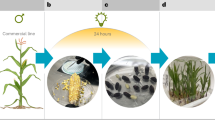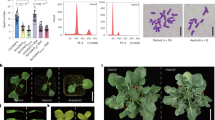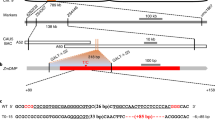Abstract
Haploid production by outcrossing with inducers is one of the key technologies to revolutionize breeding. A promising approach for developing haploid inducers is by manipulating centromere-specific histone H3 (CENH3/CENPA)1. GFP-tailswap, a CENH3-based inducer, induces paternal haploids at around 30% and maternal haploids at around 5% (ref. 2). However, male sterility of GFP-tailswap makes high-demand maternal haploid induction more challenging. Our study describes a simple and highly effective method for improving both directions of haploid production. Lower temperatures dramatically enhance pollen vigour but reduce haploid induction efficiency, while higher temperatures act oppositely. Importantly, the effects of temperatures on pollen vigour and on haploid induction efficiency are independent. These features enable us to easily induce maternal haploids at around 24.8% by using pollen of inducers grown at lower temperatures to pollinate target plants, followed by switching to high temperatures for haploid induction. Moreover, paternal haploid induction can be simplified and enhanced by growing the inducer at higher temperatures pre- and post-pollination. Our findings provide new clues for developing and using CENH3-based haploid inducers in crops.
This is a preview of subscription content, access via your institution
Access options
Access Nature and 54 other Nature Portfolio journals
Get Nature+, our best-value online-access subscription
$29.99 / 30 days
cancel any time
Subscribe to this journal
Receive 12 digital issues and online access to articles
$119.00 per year
only $9.92 per issue
Buy this article
- Purchase on Springer Link
- Instant access to full article PDF
Prices may be subject to local taxes which are calculated during checkout



Similar content being viewed by others
Data availability
All data supporting the findings of this study are available within the paper. Source data are provided with this paper.
References
Jacquier, N. M. A. et al. Puzzling out plant reproduction by haploid induction for innovations in plant breeding. Nat. Plants 6, 610–619 (2020).
Ravi, M. & Chan, S. W. Haploid plants produced by centromere-mediated genome elimination. Nature 464, 615–618 (2010).
Ishii, T., Karimi-Ashtiyani, R. & Houben, A. Haploidization via chromosome elimination: means and mechanisms. Annu. Rev. Plant Biol. 67, 421–438 (2016).
Ravi, M. et al. The rapidly evolving centromere-specific histone has stringent functional requirements in Arabidopsis thaliana. Genetics 186, 461–471 (2010).
Seymour, D. K. et al. Rapid creation of Arabidopsis doubled haploid lines for quantitative trait locus mapping. Proc. Natl Acad. Sci. USA 109, 4227–4232 (2012).
Wijnen, C. L. et al. A complete chromosome substitution mapping panel reveals genome-wide epistasis in Arabidopsis. Preprint at bioRxiv https://doi.org/10.1101/436154 (2018).
Flood, P. J. et al. Reciprocal cybrids reveal how organellar genomes affect plant phenotypes. Nat. Plants 6, 13–21 (2020).
Wijnker, E. et al. Reverse breeding in Arabidopsis thaliana generates homozygous parental lines from a heterozygous plant. Nat. Genet. 44, 467–U156 (2012).
Chen, L. & Liu, Y. G. Male sterility and fertility restoration in crops. Annu. Rev. Plant Biol. 65, 579–606 (2014).
Kuppu, S. et al. A variety of changes, including CRISPR/Cas9-mediated deletions, in CENH3 lead to haploid induction on outcrossing. Plant Biotechnol. J. 18, 2068–2080 (2020).
Karimi-Ashtiyani, R. et al. Point mutation impairs centromeric CENH3 loading and induces haploid plants. Proc. Natl Acad. Sci. USA 112, 11211–11216 (2015).
Kuppu, S. et al. Point mutations in centromeric histone induce post-zygotic incompatibility and uniparental inheritance. PLoS Genet. 11, e1005494 (2015).
Heckmann, S. et al. The E2F transcription factor family regulates CENH3 expression in Arabidopsis thaliana. Plant J. 68, 646–656 (2011).
Ahmadli, U. et al. High temperature increases centromere-mediated genome elimination frequency and enhances haploid induction in Arabidopsis. Plant Commun. https://doi.org/10.1016/j.xplc.2022.100507 (2022).
Wang, N., Gent, J. I. & Dawe, R. K. Haploid induction by a maize cenh3 null mutant. Sci. Adv. 7, eabe2299 (2021).
Kelliher, T. et al. Maternal haploids are preferentially induced by CENH3-tailswap transgenic complementation in maize. Front. Plant Sci. 7, 414 (2016).
Lv, J. et al. Generation of paternal haploids in wheat by genome editing of the centromeric histone CENH3. Nat. Biotechnol. 38, 1397–1401 (2020).
Zhu, J. et al. Slowing development restores the fertility of thermo-sensitive male-sterile plant lines. Nat. Plants 6, 360–367 (2020).
Jiang, C. et al. A reactive oxygen species burst causes haploid induction in maize. Mol. Plant 15, 943–955 (2022).
Li, X. et al. Single nucleus sequencing reveals spermatid chromosome fragmentation as a possible cause of maize haploid induction. Nat. Commun. 8, 991 (2017).
Liu, C. et al. A 4-bp insertion at ZmPLA1 encoding a putative phospholipase A generates haploid induction in maize. Mol. Plant 10, 520–522 (2017).
Kelliher, T. et al. MATRILINEAL, a sperm-specific phospholipase, triggers maize haploid induction. Nature 542, 105–109 (2017).
Gilles, L. M. et al. Loss of pollen-specific phospholipase NOT LIKE DAD triggers gynogenesis in maize. EMBO J. 36, 707–717 (2017).
Tan, E. H. et al. Catastrophic chromosomal restructuring during genome elimination in plants. eLife 4, e06516 (2015).
Ravi, M. et al. Meiosis-specific loading of the centromere-specific histone CENH3 in Arabidopsis thaliana. PLoS Genet. 7, e1002121 (2011).
Lermontova, I. et al. Knockdown of CENH3 in Arabidopsis reduces mitotic divisions and causes sterility by disturbed meiotic chromosome segregation. Plant J. 68, 40–50 (2011).
Xing, H. L. et al. A CRISPR/Cas9 toolkit for multiplex genome editing in plants. BMC Plant Biol. 14, 327 (2014).
Xie, X. et al. CRISPR-GE: a convenient software toolkit for CRISPR-based genome editing. Mol. Plant 10, 1246–1249 (2017).
Allen, G. C., Flores-Vergara, M. A., Krasynanski, S., Kumar, S. & Thompson, W. F. A modified protocol for rapid DNA isolation from plant tissues using cetyltrimethylammonium bromide. Nat. Protoc. 1, 2320–2325 (2006).
Yang, L., Wang, Z. & Hua, J. Measuring cell ploidy level in Arabidopsis thaliana by flow cytometry. Methods Mol. Biol. 1991, 101–106 (2019).
Acknowledgements
We thank X.-F. Cao, M.-X. Sun and J.-X. Zhai for helpful discussion. We thank S.W.L. Chan for sharing the GFP-tailswap and GFP–CENH3 seeds, and we thank Z.-N. Yang for sharing the res1 seeds. We thank Q.-J. Chen for sharing the pHEE401E construct. This work was supported by the Hainan University Startup Fund (grant no. RZ2100003224 (J.L.)).
Author information
Authors and Affiliations
Contributions
J.L. designed and supervised the overall research. Z.W., M.C., H.Y., Z.H., Y.-F.Y. and H.X. performed the experiments. Z.W. and J.L. analysed the data. J.L., Z.W. and H.Y. wrote the manuscript with input from all authors. S.-P.Y. and K.-K.Y. participated in the discussion of the study and revision of the manuscript. All authors contributed to the data collection, presentation and manuscript writing.
Corresponding author
Ethics declarations
Competing interests
Hainan University has filed a provisional patent application in China that is based on results described in the paper. J.L., Z.W., H.X., M.C., H.Y. and Y.-F.Y. are listed as co-inventors on this application. The remaining authors declare no competing interests.
Peer review
Peer review information
Nature Plants thanks Zhong-Nan Yang, Jian Lv and the other, anonymous, reviewer(s) for their contribution to the peer review of this work.
Additional information
Publisher’s note Springer Nature remains neutral with regard to jurisdictional claims in published maps and institutional affiliations.
Extended data
Extended Data Fig. 1 GFP-tailswap fertility is ambient temperature-sensitive.
a, A picture of representative inflorescence phenotypes of Col-0 and GFP-tailswap grown under different conditions. Scale bar, 1 cm. b, Representative silique image of GFP-tailswap plants were grown at 25 °C and subsequently grown at 18 °C. Scale bar, 1 cm. c, Representative silique image of GFP-tailswap plants were grown at 18 °C and subsequently grown at 25 °C. Scale bar, 1 cm. d, Representative image of Col-0 and GFP-tailswap siliques under different conditions. Scale bar, 1 cm. e, The proportion of normal seeds, aborted seeds, and undeveloped ovules, which are collected from Col-0 and GFP-tailswap plants produced by selfing under different conditions.
Extended Data Fig. 2 The male fertility of GFP-tailswap is restored very early at low temperatures.
a, Alexander staining for the anthers of the first and the fifth flowers of GFP-tailswap (18 °C). Twice experiments independently were repeated with similar results. Scale bar, 100 μm. b, Representative image of the first and the fifth flower phenotypes of GFP-tailswap (18 °C). The filaments of the first flower cannot reach the stigma, but the filaments of the fifth flower can reach the stigma. Twice experiments were repeated independently with similar results. Scale bar, 1 mm.
Extended Data Fig. 3 Determination of haploid plants by phenotypes and flow cytometry analysis.
a, The representative photograph for offspring of a crossing between GFP-tailswap (male) and gl1 Ler (female). Scale bar, 5 cm. b, Scatter plot comparing the relative size of nuclei from debris using side scatter (SSC-A) and DNA fluorescence (y-axis). Staining DNA with propidium iodide (PI). A gating region (P2) was selected by adjusting the position of the black dashed line to exclude background signals. In this case, real signals of the diploid accounted for 8.53% of the total captured signals, and real signals of the haploid accounted for 6.55% of the total captured signals. c, Count the number of nuclei resulting from the described (in b) gating with different relative DNA content.
Extended Data Fig. 4 Seed abortion phenotype of hybrid seeds after haploid induction.
a, Phenotype images of mature seeds from outcrossing. Mature seeds from wild-type (Col-0) and GFP-tailswap pollinated with gl1 Ler pollen, respectively. Plants were grown at 22 °C and then transferred to 18 °C, 22 °C, and 25 °C just after hybridization. b, Proportion of different abortion levels of mature seeds resulting from the outcrossing described in (a). Mature seeds were collected, and divided into four groups: dark inviable seeds, wrinkled seeds (size < 1/2), wrinkled seeds (size > 1/2), and plump viable seeds.
Extended Data Fig. 5 The identification of cenh3-8 allele.
a, The cenh3-8 resulted from genome editing by CRISPR has a 276 base pair (bp) deletion in CENH3 locus. The gene structure of CENH3 is shown at top panel; the protospacer adjacent motif (red font) and 20-base pair target sequence of the gRNA (highlighted in yellow) are shown; the cenh3-8 is a 276 base pair deletion (highlighted in red) mutant. b, Protein alignment for CENH3-WT, CENH3-8 by using ClustalW. The protein of CENH3-8 has a 27 amino acids deletion at the N-terminal tail. c, A representative photograph for Col-0, GFP-tailswap, and cenh3-8 at the rosette stage. Scale bar, 1 cm. d, The viability of pollen grains of Col-0 and cenh3-8 was tested by coloration with Alexander’s stain, the Col-0 and cenh3-8 plants were grown at 18 °C, 22 °C, and 25 °C. Twice experiments were repeated independently with similar results. Scale bar, 100 μm.
Extended Data Fig. 6 The expression of CENH3 decreased in cenh3-8.
a, Schematic diagram of CENH3 and cenh3-8 structure. F and R represent a pair of primers used in qRT-PCR. b, Representative result from qRT-PCR analysis of CENH3 transcript levels in inflorescences of Col-0 and cenh3-8 grown under different conditions. PUX7 was used as an endogenous control for normalization. Values are the mean ± s.d. of three technical samples. Three times experiments were repeated independently with similar results.
Extended Data Fig. 7 Maternal cenh3-8 has severe function defects during seed development.
Split open of green mature siliques from reciprocal crossing between cenh3-8 and cenh3-1/+. Scale bar, 1 mm.
Extended Data Fig. 8 res1 cannot restore the temperature-sensitive male sterility of GFP-tailswap.
a, Fertile phenotypes of Col-0, res1, GFP-tailswap, and GFP-tailswap/res1 plants (22 °C). Scale bar, 5 cm. b, Alexander staining pollen grains of Col-0, res1, GFP-tailswap, and GFP-tailswap/res1 plants, the viable pollen of anthers is stained purple. Twice experiments were repeated independently with similar results. Scale bar, 100 μm.
Extended Data Fig. 9 Multiple sequence alignment of heterologous CENH3 proteins.
Multiple sequence alignment of CENH3 proteins from Arabidopsis thaliana, Brassica napus, Citrus sinensis, Gossypium hirsutum, Oryza sativa, and Zea mays. cenh3-8 lacks 27 amino acids in the N-terminal domain and is not haploid-inducible under normal conditions. As Kuppu et al., 2020 paper (doi.org/10.1111/pbi.13365) reported, they obtained two deletion mutants in the αN-helical domain near the N-terminal tail, the inducer lines were grown at 20 °C, Δ11 produced haploids at a frequency of ~16%.
Supplementary information
Supplementary Information
Extended Data Figs. 1–9 and Supplementary Tables 1.
Source data
Source Data Fig. 1
Statistical source data.
Source Data Fig. 2
Statistical source data.
Source Data Fig. 3
Statistical source data.
Source Data Extended Data Fig. 1
Statistical source data.
Source Data Extended Data Fig. 4
Statistical source data.
Rights and permissions
Springer Nature or its licensor (e.g. a society or other partner) holds exclusive rights to this article under a publishing agreement with the author(s) or other rightsholder(s); author self-archiving of the accepted manuscript version of this article is solely governed by the terms of such publishing agreement and applicable law.
About this article
Cite this article
Wang, Z., Chen, M., Yang, H. et al. A simple and highly efficient strategy to induce both paternal and maternal haploids through temperature manipulation. Nat. Plants 9, 699–705 (2023). https://doi.org/10.1038/s41477-023-01389-x
Received:
Accepted:
Published:
Issue Date:
DOI: https://doi.org/10.1038/s41477-023-01389-x



